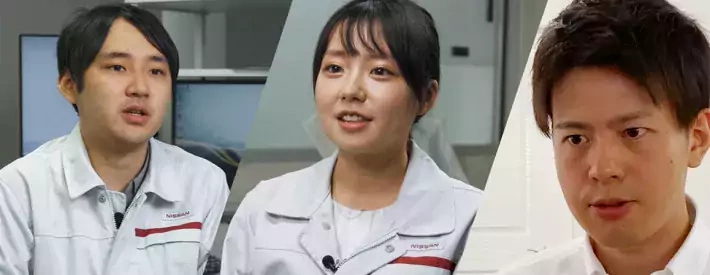A peek inside Nissan’s research centre in Japan

There’s an enormous amount happening in automotive at the moment, but research teams around the world are looking even further into the future, developing the technologies to keep the world moving
At the heart of Nissan’s research facilities in Japan is a team of forward-thinking and inquisitive minds. Their job is to solve problems by pushing boundaries and develop the technologies that will power the industry for decades to come.
These are three of the researchers’ stories.
Creating the ideal metal powder
Moe Mekata is a 3D printing materials researcher. Since her university days, Moe has been interested in production technology. She decided to join Nissan, rather than other manufacturers in different industries, because car production involves a variety of manufacturing processes.
With a sparkle in her eye, Mekata says: “Making metal parts with 3D printers changes the world of car manufacturing. This is because 3D printers can produce parts of any shape without a mould. This allows us to reduce weight by utilizing a 3D structural model and component integration. In addition, 3D printers enable us to vary the strength of a part or its materials (like aluminium or iron) depending on the part itself or its required performance. It’s a dream! We’ll soon be able to create specific parts as requested by engineers.”
The material used in this kind of 3D printing is metal powder. The grains that make up the powder are piled up, fused layer by layer, and formed into a single piece. Unlike conventional parts production – which requires casting, cutting and welding – this method reduces waste. Moe’s research focuses on the development of the metal powders used in the process. One of the challenges leading up to commercialization is to improve the quality of the powder while keeping costs low.
3D printers have gained attention not only for their efficiency and the improvement of overall production quality. But also because they serve an important role in supporting Nissan’s efforts to achieve carbon neutrality. 3D-printed parts can make electric vehicles (EVs) lighter, and thereby increase driving range. This is especially important because EVs tend to be heavier due to the battery packs they carry. By unifying the parts creation process, which previously relied on a multi-stage method, 3D printers optimize the shape of the part in a single step, reducing waste material.
“It’s the overall powder quality that determines the final performance of the 3D printed parts. That’s why we’re aiming to develop new, high-quality powders that no one else has put into practical use,” says Mekata.
All-solid-state batteries
All-solid-state technology represents the next-generation of batteries. Hiroki Kawakami and Kazuhiro Yoshino are working to achieve a breakthrough for the practical application of this new battery technology. Kawakami is collaborating with researchers and students from around the world at Purdue University in the US, while Yoshino is working with researchers at the Nissan Research Centre in Japan.
Lithium-ion batteries used in many EVs have a liquid electrolyte that conducts lithium-ion. In contrast, the electrolyte in an all-solid-state lithium-ion battery is – by definition – solid.
“The biggest advantage of all-solid-state batteries is the significant increase in energy density. By using electrode materials that store more lithium-ion and electrons, more energy can be stored in a smaller volume.” Yoshino enthusiastically adds, “If this battery is used in EVs, we can expect dramatically increased range. The solid electrolyte could also make charging faster. For these reasons, all-solid-state batteries will be key in accelerating widespread use of EVs.”
As part of Nissan's overseas assignment program for young researchers, Kawakami conducts daily simulations to investigate what is happening inside the battery and its performance. He sends this information to the Nissan Research Centre, where Yoshino uses it to make a prototype and test it as an actual, physical battery. Together with his colleagues, he conducts experiments to determine if the target performance is achievable.
So, what kind of breakthrough is needed for the practical application of all-solid-state batteries?
"One of the most difficult aspects of developing all-solid-state batteries is the contact between active material particles – which store lithium-ion in the electrodes – and the electrolyte particles – through which the lithium-ion passes," Kawakami says.
“For better contact, we need a machine that applies high pressure from the outside. The key is to ensure sufficient contact, even at low pressure, between the active material of the electrodes and the electrolyte. We’re working hard every day to find a solution to this problem through a process of trial and error.”
With the same enthusiastic sparkle in his eye as Mekata, Hiroki explains: "There are still many things we don't know about what happens inside the battery. To understand it completely, there are a number of issues we still need to solve. We discuss these difficult issues daily with local researchers and students, each of whom have different ways of thinking, and then exchange our views. It’s great when everyone gets on the same page to solve a problem.”




